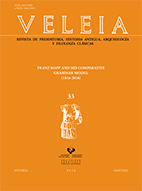El Método Comparativo: Simplicidad + Poder explicativo = Resultados
##plugins.themes.bootstrap3.article.main##
##plugins.themes.bootstrap3.article.sidebar##
Resumen
Desde su introducción como herramienta metodológica disponible para la Lingüística histórica, el Método Comparativo ha demostrado ser uno de los métodos usados más potentes y duraderos, a pesar de su aparente simplicidad. En este artículo, se exploran las bases para el Método Comparativo y, con el fin de demostrar su utilidad y poder explicativo, se proporcionan ejemplos ilustrativos de su aplicación en todos los niveles del análisis lingüístico y de su extensión, incluso, hacia ámbitos culturales.
Descargas
##plugins.themes.bootstrap3.article.details##
Fowler, M., 1957, «The Historical-Comparative Method», The Classical Journal 52.6, 259-264.
Fox, L., 1989, Kanuni I Lekë Dukagjinit. The Code of Lek Dukagjinit. Albanian text collected and arranged by Shtjefën Gjeçov. Translated, with an Introduction, by Leonard Fox, New York: Gjonlekaj Publishing Co.
Heine, B., and T. Kuteva, 2002, World Lexicon of Grammaticalization. Cambridge: Cambridge University Press.
Hock, H. H., and B. D. Joseph, 1996/2009, Language Change, Language History, and Language Relationship. An Introduction to Historical Linguistics, Berlin: Mouton de Gruyter (1st ed. 1996; 2nd ed. 2009).
Joseph, B. D., 2000, «What gives with es gibt ? Typological and comparative perspectives on existentials in German, in Germanic, and in Indo-European», Studies in Memory of Edgar C. Polomé. American Journal of Germanic Linguistics and Literatures 12.2, 187-200.
Joseph, B. D., 2001, «Historical Linguistics», in M. Aronoff & J. Rees-Miller (eds.), Handbook of Linguistics, Oxford: Blackwell Publishers, 105-129.
Joseph, B. D., 2004, «Rescuing Traditional (Historical) Linguistics from Grammaticalization "Theory"», O. Fischer, M. Norde, & H. Perridon (eds.), Up and Down the Cline - The Nature of Grammaticalization, Amsterdam: John Benjamins, 44-71.
Joseph, B. D., 2011, «Comparative Perspectives on Early Irish Bee Law», Paper presented at annual meeting of Celtic Studies Association of North America, The Ohio State University, 20 May 2011.
Joseph, B. D., 2016, «Comparative Perspectives on Bee Law in Indo-European». Paper presented at 35th meeting of the East Coast Indo-European Conference (ECIEC 35), University of Georgia, 6 June 2016.
Kuhn, A., 1853, «Ueber die durch nasale erweiterte verbalstämme», Zeitschrift fur Vergleichende Sprachforschung 2, 455-471.
von Schlegel, F., 1808, Über die Sprache und die Weisheit der Indier, Heidelberg: Mohr und Zimmer (reprinted in a new edition, 1977, by John Benjamins, Amsterdam).
Watkins, C. W., 1970, «Studies in Indo-European legal language, institutions, and mythology», in G. Cardona, H. Hoenigswald and A. Senn (eds.), Indo-European and Indo-Europeans, Philadelphia: University of Pennsylvania Press, 321-354.
Watkins, C. W., 1995, How to Kill a Dragon. Aspects of Indo-European Poetics, Oxford: Oxford University Press.
Watkins, C. W., 2000, The American Heritage Dictionary of Indo-European Roots, Boston: Houghton Mifflin. Winford, D., 2003, Introduction to Contact Linguistics, Oxford: Wiley-Blackwell.
A no ser que se indique lo contrario, los contenidos de la edición electrónica de la plataforma OJS se regulan por una licencia de uso y distribución Creative Commons Atribución-NoComercial-SinDerivadas 4.0 Internacional (CC-BY-NC-ND).
La revista no cobra ninguna compensación económica a los autores por publicar en ella y da total acceso a los archivos sin ningún tipo de embargo desde el día de su publicación electrónica. Se respeta así la política nacional de acceso abierto.
Todos los originales publicados en la revista Veleia, ya sea en su formato impreso o en el digital, son propiedad de la Universidad del País Vasco (UPV/EHU). © UPV/EHU
Los autores de artículos (sean artículos de investigación, noticias, varia o reseñas) podrán acceder a sus propias obras en la página web de la revista. Los autores podrán colocarlos en sus repositorios personales y cuentan también con la posibilidad de difusión pre-print de los artículos ya admitidos para publicar.

